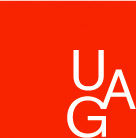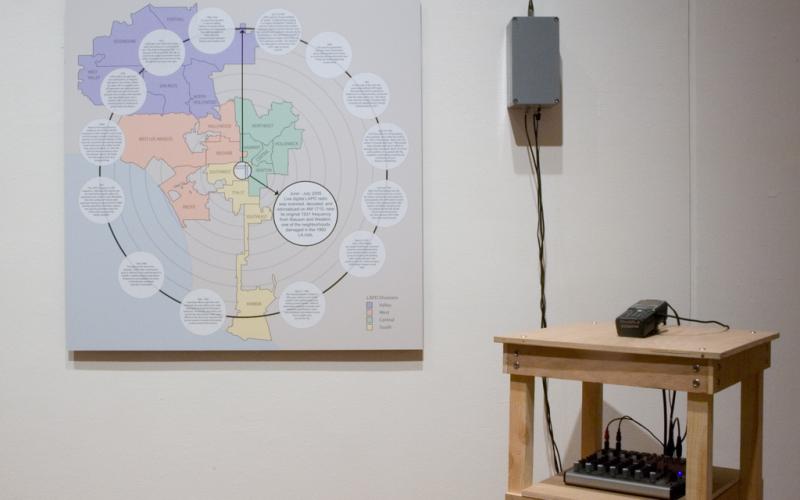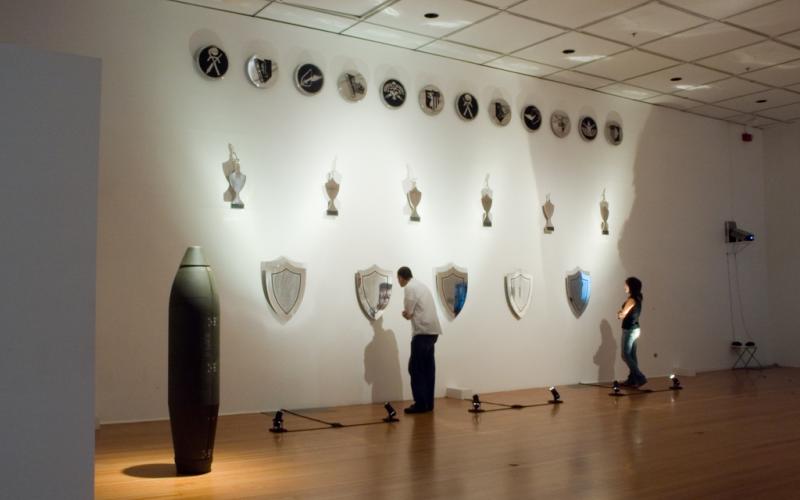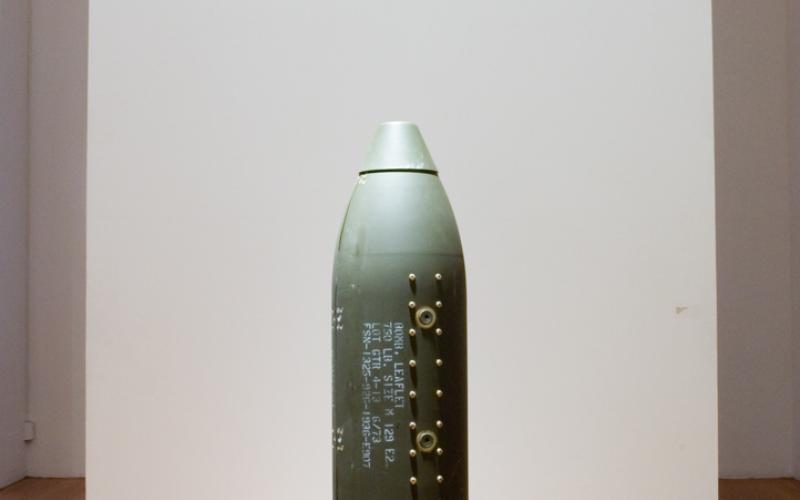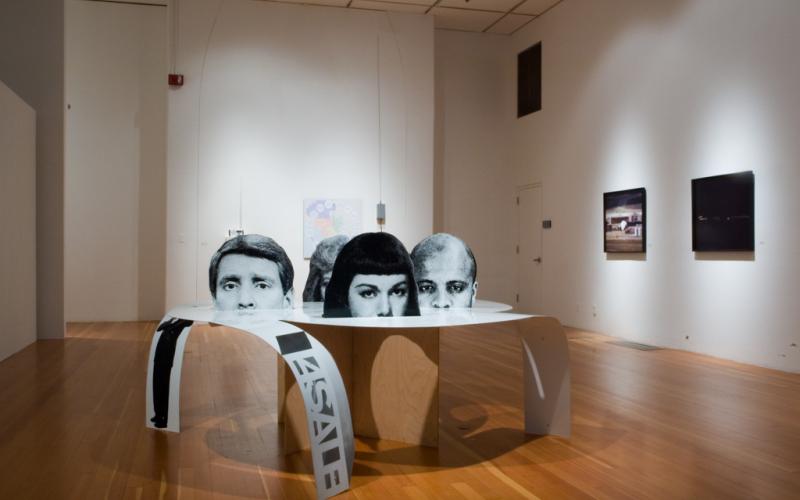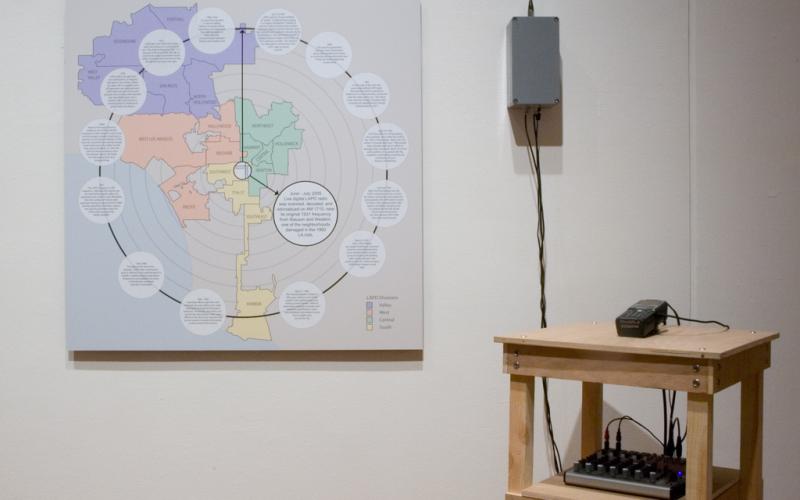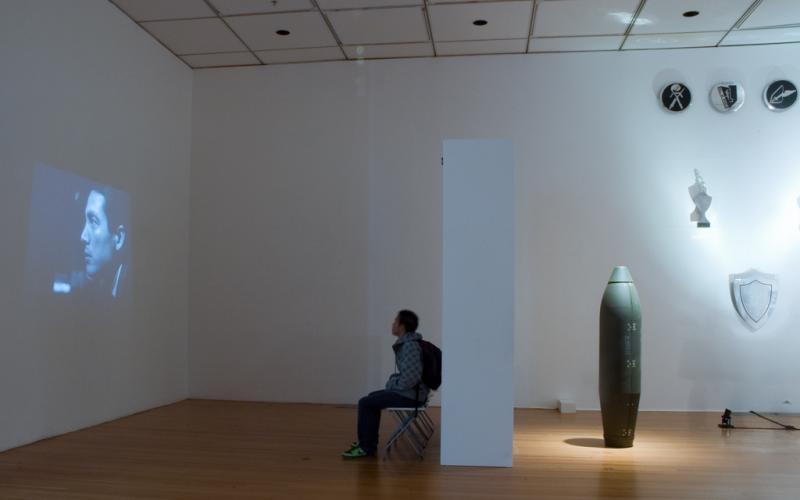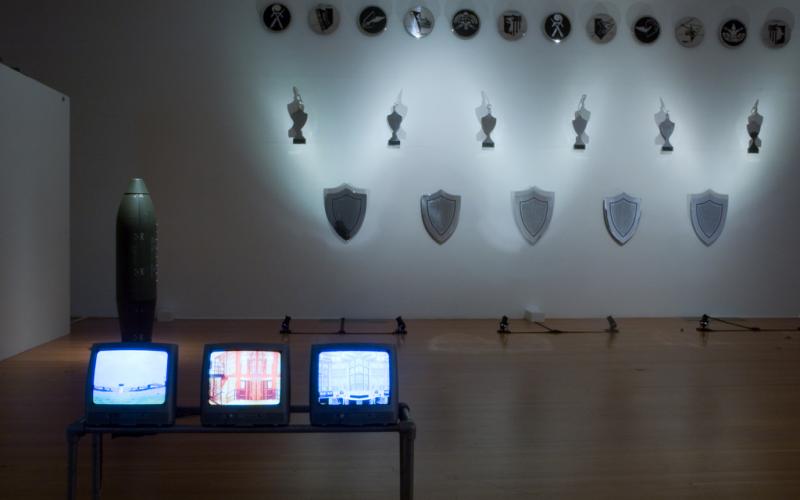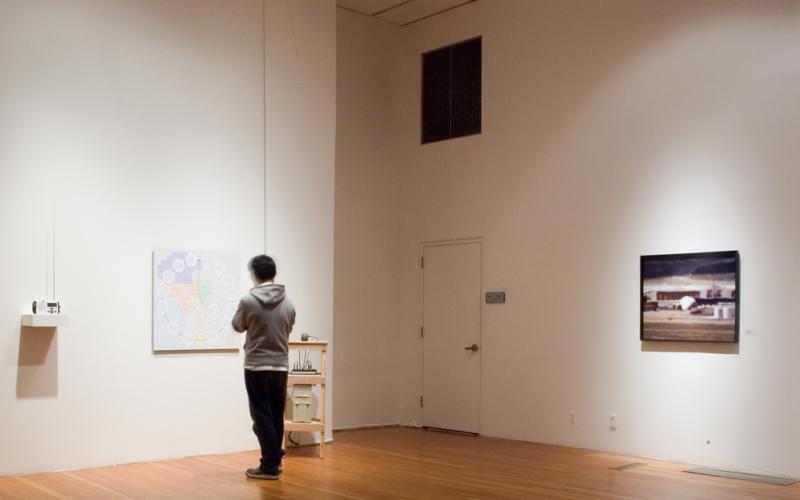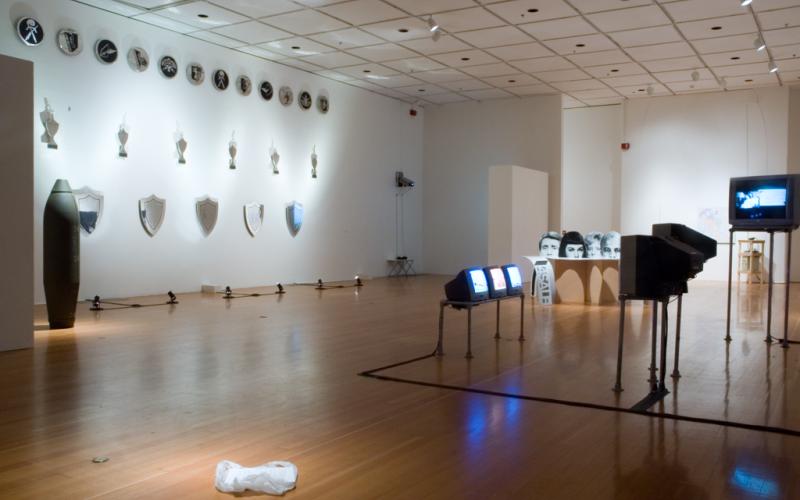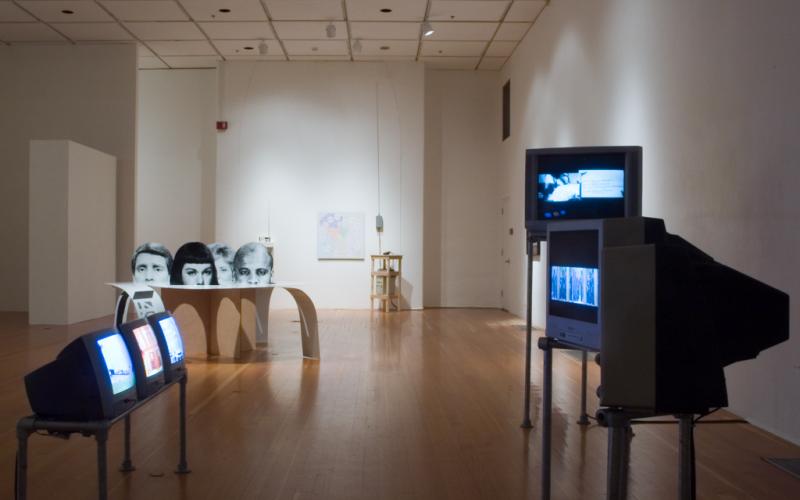FILM / VIDEO PROGRAM
Designed to foster a sustained discussion on the connections between aesthetic, political and ethical fields, The Look of Law also features a video and film program, planned in collaboration with the UCI Film and Video Center, on October 5 and October 18.
Thursday October 5, 2006
Film Screening: The Bloody Child by Nina Menkes (35mm/86 min/1996)
7pm, Humanities Instructional Building (HIB), room 100.
From http://ninamenkes.com: “ This film was inspired by a real event—a young US Marine, recently back from the Gulf War, was found digging a grave for his murdered wife in the middle of the California Mojave. Menkes turns the man’s arrest—a moment in time—into a harrowing hallucinatory journey, a mesmerizing look at the desolation of violence. Shot in North Africa and 29 Palms, California, THE BLOODY CHILD combines actual Desert Storm marines, playing themselves, text from Shakespeare’s MACBETH, and wife-murder…creating a witch’s brew Kevin Thomas of the LA TIMES called, ‘Brilliant… an awe-inspiring rigorous work of art on the highest level; one of the year’s top five films.’ ”
Wednesday, October 18, 2006
Video screening: The Look of Law
7pm, Humanities Instructional Building (HIB), room 110
This Program is FREE and OPEN to the public.
This program of six short videos is chosen from contemporary videos made mostly by visual artists who have a peripheral relationship with the current video/film world. They address the affective ramifications of state and political power using hybrid forms of verbal and textual narration that owe as much to the history of video art in galleries as they do to experimental cinema and video. Included among the contemporary works is a rarely—seen mid-1970s work by Ron Clark, which eerily foreshadows the tone of the American psyche in a post 9-11 age of homeland (in)security.
Untitled Video on Lynne Stewart and Her Conviction, The Law and Poetry
Directed by Paul Chan.
2006, US • 17 minutes 30 seconds • video
On February 10, 2005, Lynne Stewart was convicted of providing material support for a terrorist conspiracy. The first lawyer to be convicted of aiding terrorism in the United States, Stewart faces thirty years of prison and will be sentenced in September 2006. Untitled... is a video portrait of Stewart which focuses on the relationship between the language of poetry and the language of the law. Stewart speaks both languages, and employs poetry as a "knotting point" to connect ideas of beauty and justice for juries and judges alike. Untitled… takes Stewart's understanding of poetry and the law as a departure point to explore the possibilities of a poetics capable of articulating the pressures of terror and justice.
Doubt
Directed by Ron Clark
1975, US • 22 minutes • video
In Doubt, a video from 1975 made during the heyday of the New York video and performance scene centered around the Kitchen, Ron Clark attempts to generate a complex field of affectively charged connotative meanings employing minimal formal elements. Uncanny and timely in its evocation of the state of the American national psyche obsessed with secrecy and terrorism, Doubt revolves around an absent central figure, cast in doubt. The video interweaves narratives drawn from the everyday life experiences of the speakers, emerging from a convergence of Clark’s theoretical interests: Althusser, Lacan, Derrida, and Brecht. A legend and fixture of downtown New York as an influential teacher to several generations of leading figures in art, film, and academia, Clark has been the director of the Whitney Museum Independent Study Program since 1981 and its head of its studio component since 1968.
Green Love
Directed by Nils Norman and Lincoln Tobier
2004, US • 10 minutes • video
Scenes of driving around Los Angeles are activated through a voice over narrative: Two supermarket workers caught up in the political fervor of the "Super Market Strikes” decide to take things further. Radicalized at the picket line they begin to implement a series of break-away actions, using radical urban guerilla farming techniques they conspire to redesign their immediate landscape destroying parking lots, monkey wrenching cars, reclaiming surplus spaces, replanting parks, freeway ramps and median strips. This mad spree of micro-landscape design reaches its terrible climax with a standoff with the police and the ultimate deaths of our heroes.
Reference over Time
Directed by Andrea Geyer
2004, US • 19 minutes • video
In Reference over Time, an actress is rehearsing Bertolt Brecht's 1940s text "Conversation Among Refugees". The text that Brecht wrote in exile features two men sitting in a restaurant in the station in Helsingfor (Norway) talking about politics. Made in 2004 in the political climate of the United States where the proposed Patriot 2 legislation proposes to give the state the right to take away citizenship, the actress struggles to find the right tone for the words exchanged in a 1940s Europe. The men have lost their status as citizens. As refugees, conversation has become their main occupation. The “re-uttered” Brechtian text challenges and complicates the recognition of reoccurring patterns in history.
Stock Exchange
Directed by Nate Harrison*
2006, US • 12 minutes 30 seconds • video
Stock Exchange deals with the logic of a video image bank under globalization, including the commodification of the images of war and the nation state. Built around a correspondence where inquiry and response about the corporation trading in the stock video footage is played out, Nate Harrison addresses the contemporary “society of spectacle” where a contrived video depicting generic scenarios can be made and sold to accompany almost anything.
The Years to Come
Directed by Eiko Grimberg
2004, Germany/US • 14 minutes • video
The Years to Come concerns itself with the past and present of New York’s Barrier Street. The building of the Morgan company in New York, at the crossing of Broad Street and Barrier Street, still carries the traces of an event from the year 1920 when a horse cart loaded with explosive exploded, and more than three dozen people died. The case, never solved, was nonetheless alternately rumored to be an accident, an "auto bomb" or a suicide assassination attempt. Today, after September 11, 2001, when the New Yorker Financial District is once again permanently barricaded, Eiko Grimberg weaves an evocative poetic video essay on the strange convergence of past and present, where images from the Financial District show how history writes itself onto the front of buildings.
* Nate Harrison will participate in a conversation with Simon Leung and the audience after the screening.
Video Program: 96 minutes total.
CONFERENCE
Thursday October 19, 2006. 2pm- 7:30pm
Humanities Instructional Building (HIB), room 135, UC Irvine
FREE and OPEN to the Public.
“The Look of Law” is a one-day conference intended to develop dialogue between visual art producers, whose work deal with the representations of the force of “law,” and UCI faculty members from a variety of disciplines, whose areas of research intersect with the artists’ work. The primary goal of this project is to introduce to the UCI academic and campus community to contemporary art practices that address the representation of state power, in order to foster dialogue on the subject across disciplinary boundaries.
This conference is sponsored by the Center in Law Society and Culture, the Center for Global Peace and Conflict Studies, the Humanities Center, the School of Social Ecology, the School of Humanities, and the Department of Criminology, Law & Society, to coincide with an exhibition of the same name at the University Art Gallery (September 28- October 20). Those attending the conference are encouraged to attend the exhibition in the University Art Gallery, and the film and video programs on October 5 and October 18.
Panel 1 The Force of Law
2pm – 4:15pm
Presentation: Jeff Cain, artist
Respondent: Simon Cole, Assistant Professor of Criminology.
Presentation: Ashley Hunt, artist
Respondent: Jared Sexton, Assistant Professor of African American Studies
Presentation: The Speculative Archive (David Thorne, Julia Meltzer), artists
Respondent: Dina Al-Kassim, Assistant Professor of Comparative Literature.
Panel 2 War’s Remains
4:30pm – 6:45pm
Presentation: Trevor Paglen, geographer, artist
Respondent: Peter Krapp, Associate Professor of Film and Media Studies
Presentation: Dorit Cypis, artist, mediator**
Respondent: Thomas Boellstorff, Associate Professor of Anthropology
Presentation: Silvia Kolbowski, artist
Respondent Bliss Lim, Assistant Professor of Film and Media Studies.
Reception
6:45pm-7:30pm
** Dorit Cypis’s project Sightlines is on view in the exhibition “Considered This…” at the Los Angeles County Museum of Art through January 15, 2007. For details please go to: http://www.lacma.org/art/ExhibCurrent.aspx#Consider
